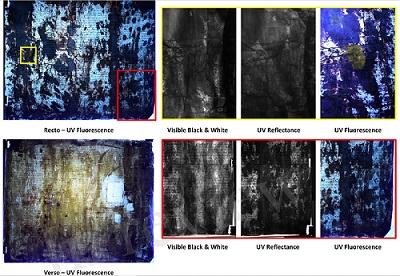Using multiple imaging techniques, including hyperspectral imaging and Fourier transform infrared (FTIR) spectroscopy, researchers at Romania’s National Institute for Research and Development in Optoelectronics have gleaned historical information from a Jewish manuscript — a pursuit that delivered valuable historical context and information about future restoration practices.
The researchers also applied x-ray fluorescence, acquiring details about the scroll’s original materials and manufacturing techniques that extend beyond those one could see with the naked eye.
The scroll was a poorly preserved manuscript containing several chapters of the Book of Esther. Having come from a private collection, little was known about the artifact’s origins or history.
“The use of complementary investigation techniques can shed light on the unknown history of such an object,” said Luminita Ghervase, a co-author on a paper introducing the work and a research scientist at the institute. “For some years now, noninvasive, nondestructive investigation techniques are the first choice in investigating cultural heritage objects, to comply with one of the main rules of the conservation practice, which is to not harm the object.”
A common technique is multispectral imaging, in which specific parts of an object are scanned over predetermined sections of the electromagnetic spectrum. Images produced via the method can reveal details about the wear and tear of an object (in this case, a manuscript) that are not obvious to the naked eye. Here, certain ultraviolet modes revealed a dark stain on the scroll, perhaps indicative of a repair using an organic material, such as resin, given that the spot strongly absorbed UV light.
The restorationists used hyperspectral imaging to determine the material basis of the ink. The researchers found two different types of ink, another indication that the artifact may have been repaired. A computer algorithm helped characterize spectral signals of individual pixels to further discriminate the materials — a method that could also be used to reconstruct the text entirely.

“The algorithm used for the materials classification has the potential of being used for identifying traces of the ink to infer the possible original shape of the letters,” Ghervase said.

Images of the manuscript obtained through UV fluorescence examination. Courtesy of Romania’s National Institute for Research and Development in Optoelectronics.
The team next used x-ray fluorescence, identifying the types of chemicals used in both the ink and the manufacturing of the parchment. The method found rich concentrations of zinc, which is linked to the bleaching process, or possibly another indication of past restoration efforts.
The final technique was FTIR spectroscopy, for a detection and identification of any other chemicals present. In measuring absorption, this method provided insights into the rate of deterioration in the collagen of the scroll, which is made from animal skin, among other insights.
The analysis of materials and evaluation of the manuscript helped the researchers determine whether any improper materials had been used in previous attempts at preservation, and whether such materials ought to be removed, Ghervase said. “Moreover, restorers can choose the most appropriate materials to restore and preserve the object, ruling out any possible incompatible materials.”
The research was published in Frontiers in Materials (www.doi.org/10.3389/fmats.2020.601339).